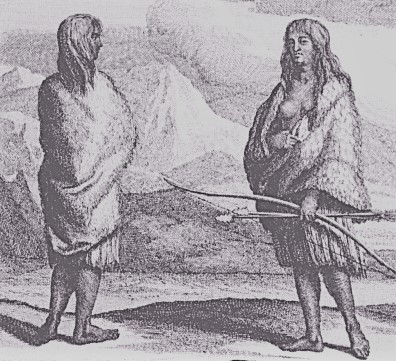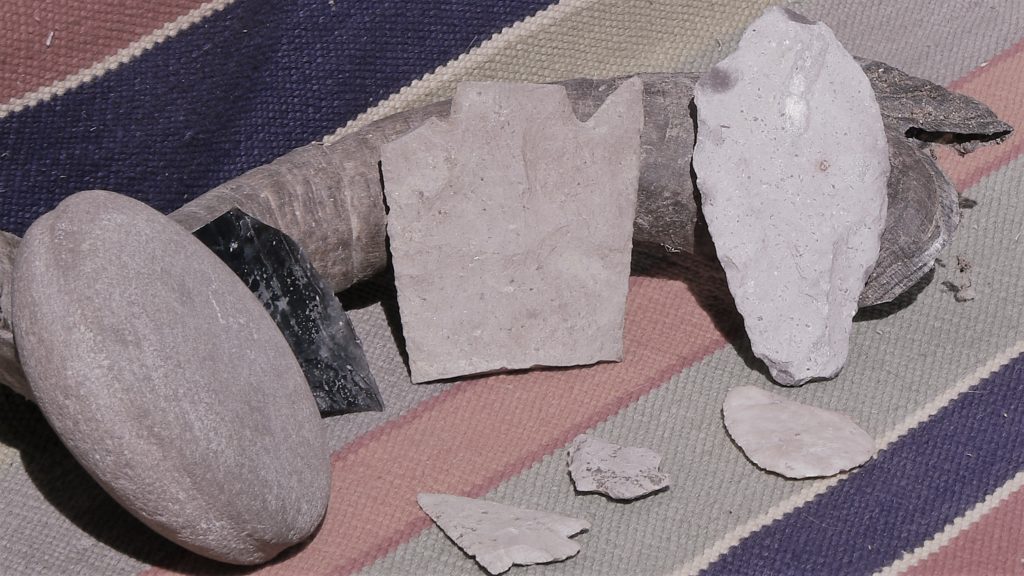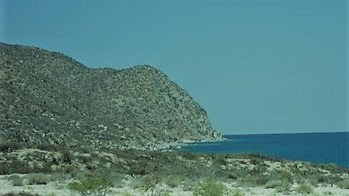Part 1 — Early Visitors to La Ventana Bay
Time: 10,000 years BCE. Location: The bluffs above the shores of present day La Ventana and El Sargento. Sea Level: 300 feet lower than the present. At dawn’s first light, the men followed a well-worn path east through grasslands to fish and gather sea food from the shore. They arrived at sunrise, and two youths floated rafts a short distance to the island to hunt for seals and turtles. The women finished gathering the last of the acorns from the live oak woodland where they had camped for the past moon. While they crushed them between metate and mano, they discussed moving camp to the base of the mountains where pitahaya were ready to harvest.
A young girl approached the small band’s oldest and most respected member, and asked her a question: where did our people come from? The elderly woman repeated the story she had learned from her mother: Many winters ago to the west, just before dawn on the shortest day of the season, Niparaja descended from the sky on the three stepping stars that mark the hunter’s waist. He stood on Cerro Del Puerto, our sacred mountain, and created all that we need to survive. Pericú is the name he gave us. It means The People. [Niparaja = Pericu deity, Cerro Del Puerto = highest peak west of La Ventana (4134 ft.)]
*****
Location: Pericú gathering place a day’s journey north of Punta Gorda. The Pericú women gathering seeds on a knoll above the shore stared in disbelief. A gigantic raft had just drifted into the bay. It made the balsas their men propelled with double-bladed paletas look like twigs floating in a tide pool. One woman sounded the alarm. [ balsas = rafts made by binding reeds or light tree trunks together, paletas = paddles ]

Fortún Ximénez, and his fellow mutineers dropped ancla and went a tierra in the mythical land of California, first imagined in a popular 16th century novel. They were the first Europeans to set foot on the Baja California peninsula. Some would be the first to die there. [ancla = anchor, a tierra = ashore]
The Spaniards came ashore to find water. When they saw the women, they knew they would find una fuente nearby. The sailors whistled and joked as they approached the group who watched the extraños with apprehension. [ fuente = source, extraños = strangers ]
This will be más fácil than slitting Becerra’s throat and commandeering the ship, Fortún thought to himself. Cortés had sent Becerra to look for an expedition that had vanished without a trace. Fortún was an exceptional pilot, but he didn’t like taking orders. He preferred looking for the island of pearls described in the popular novel. For many Spaniards in 1533, that was evidencia enough that it existed. [ más fácil = easier, evidencia = evidence ]
The Pericú men appeared without warning. What they saw angered them. Arrows were already nocked in their bowstrings. But it was the strings of pearls around their necks that distracted the sailors. They missed the signal the Pericú leader gave to kill the crude intruders. Before Fortún could react, una flecha pierced his heart, and twenty of the crew would soon be muerto. The survivors escaped to the ship. They sailed home with tales of pearls that spawned new expeditions, some that would never be heard from again. [ flecha = arrow, muerto = dead ]
Fortún and his crew’s deadly encuentro with an indigenous Baja tribe did not stop further exploration by Europeans. Instead, the lure of pearls continued to influence the course of Baja history for the next 400 years. This included the founding of the pueblo of La Ventana. [ encuentro = encounter ]

In 1535, Cortés led an expedition to establish a settlement where Fortún Ximénez died . A chubasco blew his ship off rumbo, and a falling yard arm killed his pilot. Cortés took the helm and guided the ship through the darkness to an anchorage in the lee of an island. [ chubasco = violent and sometimes sudden summer storm, rumbo = course ]
At dawn, Cortés saw that they were anchored at the entrance to a large bay. He named it Bahía de San Felipe for the saint’s day that his buque/navio and crew found refuge from the storm. He named the island Santiago to honor the patron saint of Spain. Across the water to the west, smoke spiraled up from campfires along the bluffs above the shore. Steep mountains backed a sloping alluvial plain drained by arroyos that opened onto a belt of sandy beaches. They sailed north past a promontory, and followed the coast until they reached the bay they were seeking. There, Cortés established the short-lived pueblo of Santa Cruz, the first European settlement in Baja. [ buque/navio = ship ]

*****
Sixty years later, Vizcaíno won a pearl-fishing concession to explore the western shore of the Gulf of California. He sailed out of Mazatlán on August 24, 1596, with three ships carrying horses, soldiers, women and children. They made the crossing in 10 days, and landed (León Portillo, 1985) “at a bay that was baptized as San Felipe, the current Bay of La Ventana.”
Vizcaino and a squad of soldiers went ashore on September 3. They were met by several hundred Indios amigables who traded pearls for knives and mirrors. Without so much as asking who the land belonged to, Vizcaino claimed it for Spain, naming it Nuevo Andalucía. They explored the surrounding region, and began constructing a settlement. But in just a few days, they found the local population too dangerous, and too barbarous to be converted. The expedition sailed north on September 10, and entered the bay of Santa Cruz. Because the Indians they met there were peaceful, Vizcaino renamed it La Paz. [ Indios amigables = friendly Indians, La Paz = Peace ]
After building a stockade, Vizcaino took 80 soldiers and sailed north for 10 days. At a place near present-day Loreto, Indians in five balsas met them and used signs to welcome them ashore. Vizcaino landed 25 soldiers in the only boat they carried. When armed Indians gathered on the beach, the boat ferried 25 more soldiers ashore. They followed the Indians to their ranchería where they exchanged gifts. [ ranchería = organized band of hunting-and-gathering Baja Indians occupying a seasonal settlement ]
All went well until a soldier struck an Indian in the chest with the butt of his harquebus. Vizcaino ordered a retreat and sent a boatload of soldiers to the ship while the others formed a rear guard. Five hundred Indians suddenly attacked. The soldier’s noisy harquebuses did not frighten the Indians until one was hit and fell bleeding to the ground.
When the boat returned and picked up the shore detachment, the archers showered them with arrows, and the vessel capsized. In their heavy armaments, 19 drowned, and only 7 made it back to the ship. Without a boat to go ashore, Vizcaino returned to La Paz. Another catástrofe struck when a viento fuerte blew sparks from a campfire and ignited a hut. Before they could extinguish the flames, the inferno destroyed half the structures and food supply. The second attempt to establish a settlement in Baja California failed. [ catástrofe = catastrophe, viento fuerte = strong wind ]
*****
Eighty-seven years later in 1683, indigenous tribes repelled two more attempts by Spain to colonize the peninsula. Finally, in 1695, the Jesuit priest Salvatierra founded the first permanent Spanish settlement in Baja California at Loreto. During the next 70 years, a total of 23 missions would be established by the Jesuits. During that same period of time, more than 40,000 of the peninsula’s estimated 60,000 indigenous people died, primarily from recurrent epidemics of European diseases.
*****
Tom at BajaNightSky@gmail.com
Continue to Part 2: A diving bell deployed at Cerralvo? Baja’s first tycoon . Murder at Santa Ana.
Further Reading
- León Portillo (1985) Cartografía y Crónicas de la Antigua California
- Sands (2015) Brief History of the Cape Region
- Sands (2015) The Mystery of the Pericues
- Shelvocke (1722) A Description of the Southernmost part of California, Pacific Adventures Number Two (1940)
- Fujita (2014) A paper about the Rock Art, Settlement Patterns, Myths of Prehistoric Inhabitants of the Cacachilas